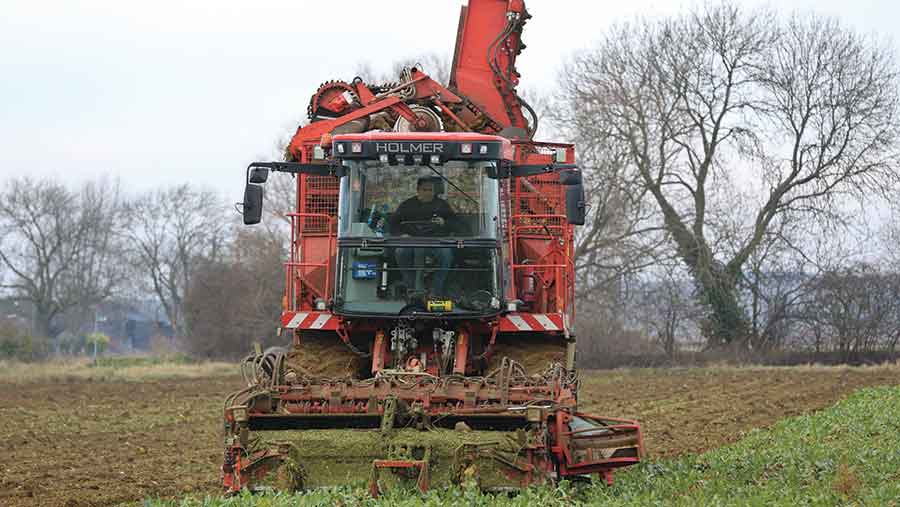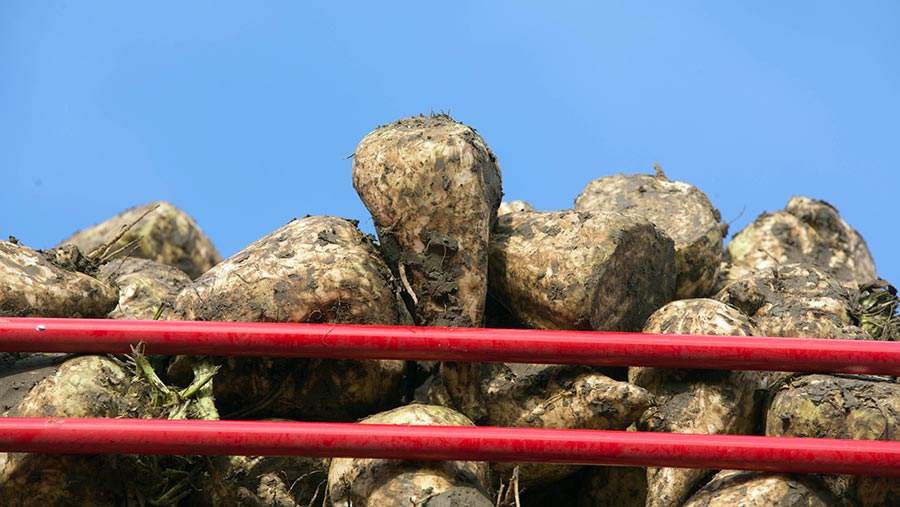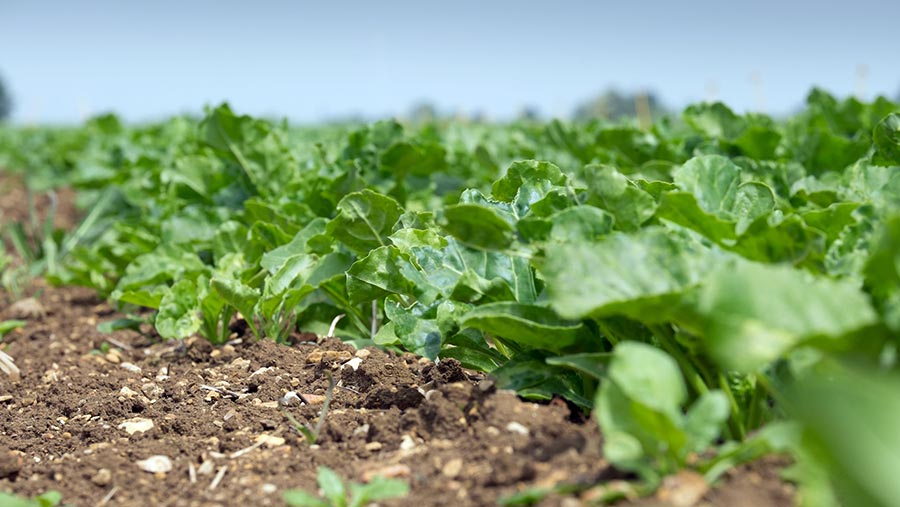Advice on using starter fertiliser to lift sugar beet yields
 © Tim Scrivener
© Tim Scrivener Using starter fertiliser at drilling in sugar beet can improve crop establishment and early growth.
However, the challenge is converting this head start into extra yield in every situation, say experts.
The use of placement starter fertiliser – which places liquid or granular nutrients in the seedling root zone at planting – is well established in precision-drilled crops such as maize and oilseed rape across the UK.
See also: Sweeter sugar beet deal is attracting new growers
Off the back of this success, interest has grown among British sugar beet growers looking to improve crop establishment – perhaps the most critical phase to get right to produce bumper beet yields.
Fast emergence
Getting the crop out of the ground and to the six-leaf stage as quickly as possible is vital. This allows the crop to maximise its use of solar radiation during early plant development.
Germain’s Xbeet plus seed priming technology has dramatically shortened this critical period since its introduction, and it is hoped starter fertiliser will cut this time further.
Hutchinson’s technical manager Dick Neale believes it is a practice with promise and is worthy of investigation, particularly as there is a growing trend for less-intensive tillage ahead of establishing sugar beet.

© Tim Scrivener
This means you don’t get as much oxygen into the soil to help with mineralisation, so there are less available nutrients for any newly established crop to scavenge.
“Many growers still use a traditional approach of applying phosphorus, potassium, sodium and boron in the autumn and ploughing down, or use liquid applications on top of ploughing ahead of seed-bed preparation.
“However, you ideally want the fertiliser around the growing seed and we now have good formulations of fertiliser that aren’t detrimental to establishment when placed at drilling, as was the case in the past,” he explains.
Phosphorus boost
Starter fertilisers can be delivered in two ways at drilling: either in liquid form or micro-granular – in products such as Primary-P. They are typically made up of phosphorus, with some nitrogen, potash, magnesium, sulphur and zinc.
Phosphorus is the key component, as young seedlings struggle to access the immobile nutrient, particularly in deficient soils. P is key to quick establishment and root growth early in the crop development.
“You need some luxury P and although there is a debate about yield benefit when using starter fertilisers, my argument is that you are using a very efficient form when placing it with the seed.
See also: Peas dominate new additions to pulse recommended list
“You aren’t necessarily going to get a yield response, but if you are giving the crop a good start, it is going to be stronger, more robust to adverse conditions and it will compete with weeds better too,” says Mr Neale.
With a granular product such as Primary-P, he says a rate of 5-10kg/ha is required in sugar beet – depending on background soil fertility and use of any farmyard manures – and would typically cost between £10-£40/ha.
Mr Neale doesn’t advocate a blanket approach and says a decision on its use should be on a field-by-field and seasonal basis.
“I would use soil zones to dictate where you use it and make a decision depending on the year. If conditions aren’t good, that’s when you will see the greatest benefit,” he adds.
British trials
So far, much of the information available to growers on starter fertiliser in sugar beet is from fertiliser companies or from abroad, with growers in the US widely adopting the practice.
Simon Bowen, knowledge exchange and crop progression lead at the British Beet Research Organisation, says a UK knowledge gap on starter fertiliser needs to be filled. This prompted the research group to conduct both farm-scale and small replicated plot trials in 2016.
“It has been successful in other crops, but is it worth adapting your sugar beet drill to use starter fertiliser? That’s what we have set out to establish,” he adds.

© Tim Scrivener
The trials have focused on placement of N and P and although results are incomplete, Dr Bowen says early indications from yield digs show there has been little or no yield advantage when using placement starter fertilisers this season.
This is particularly the case on one trial site with a heavier soil type and where turkey muck was applied before establishment, so background fertility was high.
However, on a site near Sutton Bonnington, north of Loughborough, plots were drilled into lighter land with inherently lower fertility, so some early-season differences were picked out.
“We saw a difference in early-season development in some treated plots, but any advantage wasn’t carried through to yield.
“There was a monsoon in June that stopped crops in their tracks as they suffered from waterlogging, so any advantage may have been lost,” he explains.
Marginal gains
With yield advantages of between 2-5% for placed nitrogen and slightly less for phosphate in places where the practice is common, such as the US, Dr Bowen says gains are marginal. Therefore, these gains can easily be swallowed up by negative environmental factors.
He says growers should exercise caution before widespread adoption and if establishment issues are being experienced on farm, a better starting point would be to investigate the underlying causes, which could be anything from soil compaction to beet cyst nematode.
“It is about understanding your land and identifying where you are losing any advantage, rather than treating the symptoms using starter fertilisers.”
See also: Analysis: What the new recommended list means for growers
The British Beet Research Organisation will be presenting comprehensive results of the 2016 starter fertiliser trials at their winter conference and continuing trials into the 2017 campaign to keep testing the technology across a range of situations.
“If there are any growers using starter fertiliser in their sugar beet, they should get in touch. We’d be happy to work with them to measure any potential benefits that might be achieved in their crops,” adds Dr Bowen.
Scandinavian research shows sugar yield boost
The Nordic Beet Research Organisation in Denmark and Sweden has looked closely at placement of nitrogen and starter P fertiliser and now have five seasons of data.
It is perhaps the most comprehensive piece of research in comparable conditions to those experienced in the UK and while differing seasons and sites will influence results, broad conclusions can be drawn:
- Placement (5-10cm below and to the side of the seed – see diagramme below) of some of the nitrogen fertiliser (50-100kg/ha) on average gave a 3% increase in crop yield (range 1-8%)
- Use of placed phosphate (20kg/ha) resulted in improved canopy development. Normalised Difference Vegetation Index measurements, which quantify light absorption and, therefore, the level of photosynthetic activity, showed an average increase of 21% where starter P was placed.
- Differences were seen in canopy cover, equating to >10% greater canopy cover where the starter P was used.
- This translated into an average increase of 0.7t/ha of sugar (note: sugar, not crop yield)


